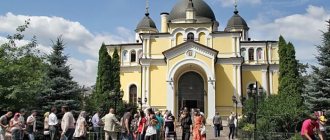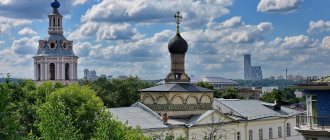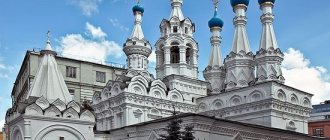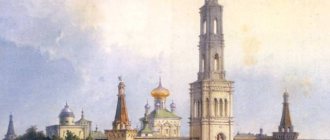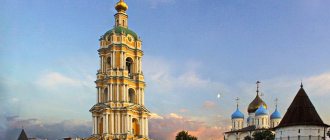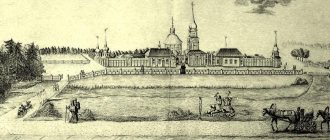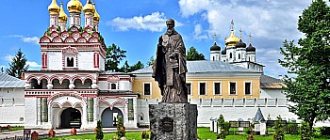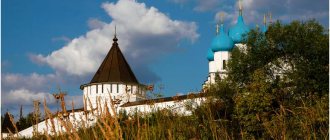Monasteries of Moscow: location, history, photos. Excursions to the monasteries of Moscow.
- Last minute tours
to Russia
- Great
Moscow, pl. Donskaya, 1the very best
Donskoy Monastery
Great
1 review
Moscow, pl. Donskaya, 1
There are few quiet places in Moscow. Donskoy Monastery is one of them. The bustle of the city does not penetrate behind the powerful walls. Peace and tranquility reign here, protected by linden alleys, an apple orchard and a strict cemetery. The main miracle in the history of the monastery is the unexpected discovery of the holy relics of St. Tikhon.
- Fine
Moscow, Novodevichiy proezd, 1
most unesco
Novodevichy Convent
Fine
3 reviews
Moscow, Novodevichiy proezd, 1
The Novodevichy Convent is one of the most beautiful monasteries in Moscow, today it belongs to the Historical Museum. But services are also held in churches. As can often be found in the capital, the historical heritage in the form of a museum part and the spiritual component harmoniously coexist in one place.
- Fine
Moscow, st. Danilovsky Val, 22
the very best
St. Daniel's Monastery
Fine
1 review
Moscow, st. Danilovsky Val, 22
Danilov Monastery is the oldest in Moscow. Tradition says that it was founded in 1282 by the son of Alexander Nevsky, Prince Daniil. A brick wall with seven towers appeared around the monastery in the 17th century. During the years of Soviet power, the monastery was converted into a children's colony.
- Moscow, Andreevskaya embankment, 2
St. Andrew's Monastery
Moscow, Andreevskaya embankment, 2
Tradition dates the establishment of the men's monastery “at Vorobyovykh Kruchi, in Plennitsy” to the 13th century, but early documentary evidence about it dates back only to the middle of the 16th century. Until the end of the 16th century. The monastery was called the Preobrazhenskaya Hermitage. - Moscow, st. m. Trubnaya, st. Petrovka, 28/2
Vysoko-Petrovsky Monastery
Moscow, st.
m. Trubnaya, st. Petrovka, 28/2 Pilgrims are attracted by the Vysoko-Petrovsky Monastery, which is located in Moscow. But even tourists indifferent to Orthodoxy will find a lot of interesting things here. The Vysoko-Petrovsky Monastery houses churches that are magnificent from an architectural point of view. - Moscow, per. 2nd Zachatievsky, 2
Conception Monastery
Moscow, per.
2nd Zachatievsky, 2 The first mention of the Zachatievsky Monastery dates back to 1360, but the current monastery was founded in 1584 with the support of Tsar Fyodor Ioannovich. The Spasskaya Church on the territory of the monastery was the home church of the Rimsky-Korsakov family. - Moscow, Maly Ivanovsky lane, 2
John the Baptist Monastery in Moscow
Moscow, Maly Ivanovsky Lane, 2
In the center of the Russian capital, not far from the Kremlin, rise the temples of one of the most ancient Moscow monasteries - St. John the Baptist. It was founded in Zamoskvorechye more than 600 years ago, and in 1530, after the birth of Ivan the Terrible, the monastery was moved to the other bank of the Moscow River - to the White City. - Moscow, Novodevichy pr-d, 1, building 12
Bell tower of the Novodevichy Convent
Moscow, Novodevichy pr-d, 1, building 12
The main vertical of the Novodevichy Convent is its 72 m high bell tower. Until the 20th century began its aggressive offensive, it was one of the three tallest buildings in the capital, second only to the bell tower of Ivan the Great. For the end of the 17th century, such a structure was unheard of progress. - Moscow, st. m. Polyanka, st. Bolshaya Ordynka, 34
Marfo-Mariinskaya Convent
Moscow, st.
m. Polyanka, st. Bolshaya Ordynka, 34 Marfo-Mariinskaya Convent, founded by Grand Duchess Elizaveta Feodorovna in 1909, does not have the official status of a monastery, but according to its charter it is close to it. Today the monastery houses the memorial museum of Elizaveta Vedorovna, a shelter for orphan girls, a charity canteen and a patronage service. - Moscow, st. m. Street 1905 Goda, Shmitovsky proezd, 2A
Monastery of St. Francis in Moscow
Moscow, st.
m. Street 1905, Shmitovsky proezd, 2A There is also a Catholic monastery in Moscow - the Monastery of St. Francis - one of the five Franciscan monasteries in modern Russia. It was founded quite recently, in 1993. Permission to build a Franciscan monastery in Moscow was given back in 1705 by Peter I. - Great
Moscow, pl. Peasant outpost, 10
Novospassky Monastery
excellent
1 reviewMoscow, pl. Peasant outpost, 10
The Novospassky Monastery, whose bell tower and domes can be seen from the final stop of a pleasure boat on the Moscow River, was founded in 1462. Boyars from the Romanov family, the same one from which the royal dynasty later emerged, were buried in this monastery.
- Fine
Moscow, st. Taganskaya, 58
museum card
Intercession Monastery in Moscow
Fine
7 reviews
Moscow, st. Taganskaya, 58
The Pokrovsky Convent in Moscow near the Intercession Gate is known primarily for the fact that it contains the miraculous relics of the blessed Elder Matrona. Every day hundreds and hundreds of believers flock to the monastery to ask Matronushka for help or advice, to thank them for their kindness.
- Moscow, Preobrazhensky Val, 17-25
Preobrazhenskaya Old Believer Community
Moscow, Preobrazhensky Val, 17-25
Since 1771, the Preobrazhensky Old Believer community, formed during the plague epidemic, has been operating in Moscow near the Preobrazhensky cemetery. Previously, there were both men's and women's buildings here. The community, abolished after the revolution, has now been revived.
Ancient monasteries with a glorious centuries-old history are a magnificent decoration of the capital. Most of them were founded in the 16th and 17th centuries. The monasteries in the city center had exclusively religious significance, while those that were built closer to the outskirts also acted as defensive fortresses and were well fortified. Today, of course, the defensive function of the monasteries has been lost; some of them remain active monasteries, and some combine museum and religious components. In total, there are 14 active monasteries in Moscow - you can visit them and pray within their walls, and there are 2 times more of those that have not survived or are not functioning.
St. Andrew's Monastery
This is an Orthodox monastery. Belongs to the stauropegial monasteries. It was created in 1648 and abolished in 1764. Various organizations worked here, ranging from a prison to a hospital for the insane. In 2013, the monastery was reopened. It is located near the foot of the Sparrow Hills in Moscow, on Andreevskaya embankment, 2.
St. Andrew's Monastery
Located in Moscow, not far from Vorobyovy Gory. Founded in 1648. The gate temple, built in 1675, has survived to this day.
St. Andrew's Monastery
Divine services . The schedule of services in the monastery is published every month; for up-to-date information, you should contact the official website of the monastery.
Address: Andreevskaya embankment, 2.
How to get there. From the Leninsky Prospect metro station on the Kaluzhsko-Rizhskaya (Orange) line or from the Gagarin Square MCC station, you need to move to the Gagarin monument and, bypassing Leninsky Prospekt, walk towards the river (about 850 meters).
From the Sparrow Hills of the Sokolnicheskaya (Red) Line you need to walk along the Moskva River embankment (about 1000 meters).
Vysoko-Petrovsky Monastery
This is a men's monastery that has received stauropegial status. The first mention of it dates back to 1317, presumably this is the year the monastery was founded. During Soviet times, the monastery was closed in 1929; it resumed its work in 2009. Located on Petrovka street, house 28/2.
Danilov Monastery
Male Orthodox stauropegic monastery. Founded in 1560, it belonged to the fortified monasteries and defended the southern borders of Moscow in the 16th and 17th centuries. In 1930, an isolation ward was opened on the territory. Children of repressed citizens of the USSR lived in it. Today the monastery operates, there is a Sunday school, church workshops, and so on. Located at: Danilovsky Val, building 22, on the right bank of the Moscow River.
Convent Moscow region: reviews
In the “nunnery” category, 13 organizations with reviews and contacts were found, the top 20 were ranked:
1. Pokrovsky Khotkov stauropegial convent - Khotkovo, lane. Cooperative, 2 24 reviews Impressive convent. If you go to Abramtsevo, it’s definitely worth stopping by here on the way. Just like in the eco-park Nomad (also on the way to Abramtsevo...
2. Kashira Nikitsky Convent - Kashira, st. Svobody, 25, Russia, Moscow region, Kashira, microdistrict. Kashira-1 13 reviews Great place. Spacious, clean, quiet, very beautiful views.
3. Anosin Borisoglebsky Stavropegial Convent - Anosino, st. Troitskaya, 37 5 reviews A gracious place, everything is being restored very beautifully, it’s light, warm and cozy, you feel at home.
4. Spaso-Vlaherna Convent - Dedenevo, st. Shkolnaya, 4 12 reviews Very beautiful, well-groomed, and the monastery servants are very kind and helpful people. I advise everyone to visit the monastery.
5. Holy Trinity Novo-Golutvin Convent - Kolomna, st. Lazareva, 11 10 reviews An amazingly beautiful place with a lot of history. Everything is well maintained, clean and beautiful. Even if you come for a few hours, you will get a lot of positive...
6. Belopesotsky Monastery - Stupino, st. Belopesotskaya, 158-159 5 reviews Very beautiful place. Delicious baked goods are sold in the Monastery.
7. Seraphim-Znamensky Skete - Bityagovo 9 reviews A wonderful holy place. Not far from Moscow, and what solitude! Thank you for the wonderful story about the monastery and its founder, Mother Tamar. Did not want…
8. Assumption Kolotsky Convent - Kolotskoye 6 reviews The monastery is more than 600 years old, the atmosphere is indescribable. The nuns created a stunning garden, and the church has an incredible amount of relics
9. Holy Trinity Mariinsky Convent - Yegoryevsk, st. Vladimirskaya, 2 A 7 reviews It’s calm here, there are a lot of beautiful old icons, it’s soulful.
10. Trinity Alexander Nevsky Convent - Akatovo 2 reviews A very beautiful monastery, it is currently being restored. The monastery is active. The entrances to it are quite satisfactory.
11. Assumption Brusensky Convent - Kolomna, Brusensky lane, 36 4 reviews The monastery was founded in 1552. Initially, the monastery was for men. During the Time of Troubles it suffered greatly and was restored as a female one. In the 1790s...
12. Alexander Nevsky Monastery - Maklakovo 3 reviews A very beautiful and interesting place. The restored Alexander Nevsky Temple!
13. Kazan Kolychevsky Convent - Kolychevo 2 reviews Open from 7.00 to 19.00 I really like visiting this monastery. It is very joyful to see that the monastery is being restored. One problem is the neighbors...
Donskoy Monastery
An Orthodox men's monastery belonging to the stauropegial monastery. The monastery was opened in 1591, the founder was Tsar Fyodor Ivanovich, the son of Ivan the Terrible. The monastery went through difficult periods: ruin during the Time of Troubles, closure during the Soviet period. There was even an anti-religious exhibition held there. Since 1991, the monastery was returned to the Orthodox Church, and it began to operate. Address: Donskaya Square, building 1.
Zaikonospassky Monastery
It is also called “teacher’s”, since a school operated within its walls, transformed into the Slavic-Greek-Latin Academy. This is a male Orthodox and stauropegic monastery. Opened in the 15th century, closed in 1929. Today the monastery is active again. The ensemble includes: Spassky Cathedral, bell tower, fraternal building and so on. Located in the center of Moscow, on Nikolskaya street, 7 – 9.
Inactive monasteries
Kremlin monasteries
| # | Image | Name | Type | Based | Abolished | State |
| 26 | Afanasyevsky Monastery | male | 1389 | XVIII century | The buildings have not survived | |
| 27 | Epiphany Trinity Monastery in the Kremlin | male | 15th century | 19th century | The buildings have not survived | |
| 28 | Ascension Monastery | female | 1386 | 1918 | The buildings have not survived | |
| 29 | Monastery of the Savior on Bor | male | 13th centuryK:Wikipedia:Articles without sources (type: not specified) [ source not specified 3298 days ] | 1933 | The buildings have not survived | |
| 30 | Miracles Monastery | male | 1365 | 1918 | The buildings have not survived |
Former monasteries within the modern boundaries of the city of Moscow
| # | Image | Name | Type | Based | Abolished | State |
| 31 | Andronikov Monastery | male | 1357 | 1918 | All buildings have been preserved except the bell tower and the necropolis. | |
| 32 | Old Alekseevsky Monastery | female | 1360 | 1837 | The buildings have not survived | |
| 33 | Epiphany Monastery | male | 1296 | 1920s | The cathedral, the bell tower, the building of the fraternal cells and the abbot's chambers have been preserved | |
| 34 | Varsonofevsky Monastery | female | 15th century | 1765 | The buildings have not survived | |
| 35 | All Saints Edinoverie Monastery | female | 1862 | 1922 | Most of the buildings have been demolished. The building of St. Nicholas Church and the cell building have been partially preserved | |
| 36 | St. George's Monastery | female | beginning of the 16th century | 1813 | Almost all buildings have been demolished. The buildings of the monastery cells have been preserved | |
| 37 | Zlatoust Monastery | male | 1412 | 1918 | Almost all buildings have been demolished | |
| 38 | Znamensky Monastery | male | 1631 | 1923 | The Znamensky Cathedral of the monastery has been preserved | |
| 39 | Elias Monastery | male | 1518 | 1626 | The Church of Elijah the Prophet has been preserved in Warm Rows, on Ilyinka | |
| 40 | Kazan Golovinsky Monastery | female | 1886 | 1929 | Buildings demolished except for the bell tower | |
| 41 | Holy Cross Monastery | male | 1547 | 1814 | The buildings have not survived | |
| 42 | Krutitsky Monastery | male | XIII century | 1785 | The buildings are mostly preserved | |
| 43 | Mironositsky Monastery | female | 15th century | 17th century | The monastery buildings have not survived, but there is a functioning Church of the Dormition of the Blessed Virgin Mary, built on the site of the monastery Church of the Myrrh-Bearing Women with the Dormition Chapel | |
| 44 | Moiseevsky Monastery | female | 16th century | 1765 | The buildings have not survived | |
| 45 | Nikitsky Monastery | female | 1582 | 1920s | Almost all buildings have been demolished. The body of the cells and a fragment of the monastery fence have been preserved | |
| 46 | Nikolo-Greek Monastery | male | XIV century | 1920s | All buildings except the cathedral have been preserved. It is planned to recreate the monastery | |
| 47 | Nikolsky Edinoverie Monastery | male | 1866 | 1923 | The buildings have been preserved, but the monastery has not been revived. | |
| 48 | Novinsky Monastery | male, after 1746 - female | 1431 | 1764 | The buildings have not survived | |
| 49 | Savvin Monastery | male, from the middle of the 17th century - female | before 1456 | 1690 | The buildings have not survived | |
| 50 | Simonov Monastery | male | 1370 | 1920 | Most of the buildings have been demolished. Part of the wall with three towers, the “New” refectory with the Church of St. Sergius of Radonezh and the fraternal building have been preserved. | |
| 51 | Sorrowful Monastery | female | 1889 | 1918 | The monastery cathedral has been partially preserved, as well as the handicraft building of the chapel and sections of the fence | |
| 52 | Strastnoy Monastery | female | 1654 | 1928 | The buildings have not survived | |
| 53 | Fedorovsky Monastery | 1627 | 1709 | The Church of Theodore the Studite has been preserved |
Nikolo-Perervinsky Monastery
This is a former monastery, its current status is the Patriarchal Metochion. The first mention of it comes in 1623. The monastery was built in neo-Byzantine and pseudo-Russian architectural styles. Closed in 1929, in 1991 services were resumed in St. Nicholas Cathedral. Located on Shosseynaya Street, 82.
Notes
- ↑ 12
[www.patriarchia.ru/db/text/3103216.html The final meeting of the spring-summer session of the Holy Synod of the Russian Orthodox Church took place]. // Patriarchia.Ru - [www.patriarchia.ru/db/text/810897.html Monastic life has been revived in the ancient Moscow Vysoko-Petrovsky Monastery]. // Patriarchia.Ru
- [www.patriarchia.ru/db/text/1106790.html The Holy Synod blessed the opening of the Zaikonospassky Stavropegic Monastery in Moscow]. // Patriarchia.Ru
- [www.patriarchia.ru/db/text/3664563.html Journals of the meeting of the Holy Synod of May 30, 2014]. Magazine No. 52. // Patriarchia.Ru
Novospassky Monastery
Male Orthodox and stauropegic monastery. The monastery was founded in 1490. History is closely connected with the Romanov dynasty. Representatives of the imperial family are buried in the monastery. Closed in 1918, the resumption of monastic activity began in 1991. The architectural ensemble was formed in the 17th – 18th centuries. Located at: Krestyanskaya Square, building 10.
Sretensky Monastery
Founded by Prince Vasily in 1397. Built in memory of the city's deliverance from the invasions of Tamerlane. This is a monastery classified as stauropegial. In 1926, the monastery was closed, and many buildings of the architectural ensemble were destroyed. The Cathedral of the Presentation of the Vladimir Icon of the Mother of God, built in 1679, miraculously survived. Since 1996, the monastery has resumed work. Geographically located on Bolshaya Lubyanka, 19, in the center of Moscow, next to Kitay-Gorod.
What is the oldest monastery in Moscow?
Since the 10th century, the Orthodox faith has played a fundamental role for the people of Rus'. In each new settlement, a church was first built, and then a city or village arose around it. People found help and peace in monasteries. This explains the large number of churches and monasteries throughout the territory of modern Russia.
Moscow is the leader in the number of religious sites, and Moscow monasteries are a real pearl of Russian architecture. The most ancient monastery in Moscow is the Danilov Monastery.
It was founded in 1282 by Moscow Prince Daniil and became the first monastery in Rus'. The youngest son of Alexander Nevsky, Prince Daniil, was a very pious man and was famous for his ability to pacify conflicts and avoid bloodshed. Therefore, it is not surprising that the first monastery in Rus' was built on his initiative.
Unfortunately, 9 years after its founding, the monastery was destroyed by the Tatar-Mongols, which led to a 200-year period of desolation of the Danilov Monastery. It was rebuilt only during the reign of Ivan the Terrible. The first Russian Tsar erected stone towers and walls around the monastery, ensuring its security and returning it to its former greatness.
From then on, the Danilov Monastery became an important element in the defense of the southern borders of Moscow. That is why not a single serious war spared it - the monastery was set on fire during the Time of Troubles, and in 1812 French troops robbed and desecrated it. During Soviet times, there was an NKVD detention center on the territory of the Danilov Monastery. Throughout history, they have tried to destroy it many times, but despite everything, it still stands and is active.
The cemetery of the Danilov Monastery contains the graves of many prominent figures of Russian culture: the poet N.M. Yazykov, writer N.V. Gogol, musician N.G. Rubinstein, artist V.G. Perov and many others.
Any visitor to the monastery will be pleasantly surprised by its well-groomed territory, bright flower beds and clean paths. Currently, on the territory of the Danilov Monastery is the residence of His Holiness the Patriarch of Moscow and All Rus', who is also the abbot of the monastery.
Every year on the last Sunday of September, a festival of Russian bells begins in the oldest Moscow monastery. At the ancient bell tower, the best bell ringers in Russia delight visitors with their booming chimes and create a magical atmosphere around them.
The monastery is located in the center of Moscow near the Tulskaya metro station.
Address: st. Danilovsky Val, 22
How to get there:
Alekseevsky Monastery
This is an unpreserved female Orthodox monastery. Previously it was located on the site of the Cathedral of Christ the Savior. It was founded in 1360. In 1837, in connection with the construction of the temple, the monastery was moved and named Novo-Alekseevsky. In 1926, the Bolsheviks completely destroyed it. In 2013, the monastery was revived, given stauropegial status and again called Alekseevsky. Today it is located at 2nd Krasnoselsky Lane, 7.
Links
women's Alekseevsky (new) • Rozhdestvensky • Zachatievsky • John the Baptist • Marfo-Mariinsky Convent • Novodevichy • Pokrovsky • Trinity-Odigitrievskaya Hermitage Inactive Extant Andronikov • Krutitskoe • Nikolsky (edinoverie) Partially preserved Epiphany • All Saints (of the same faith) • Georgievsky • Zlatoust • Znamensky • Kazan Golovinsky • Mironositsky • Nikitsky • Nikolo-Greek • Simonov • Skorbyashchensky • Fedorovsky Not preserved Kremlin: Afanasyevsky • Epiphany Troitsky • Voznesensky • Spas on Bor • Chudov
Other:
Alekseevsky (old) • Varsonofyevsky • Krestovozdvizhensky • Moiseevsky • Novinsky • StrastnoyHeterodox Catholic Monastery of Saint Francis Old Believers Preobrazhenskaya Old Believer Community
Mother of God Nativity Monastery
It is considered the oldest convent in Moscow. It was founded in 1386. It was closed in 1926; there were various educational institutions on its territory, and there were communal apartments in the cells. In 1993, the monastery began its work again. It runs Sunday and church singing schools. Located at the intersection of Rozhdestvensky Boulevard and Rozhdestvenka Street.
Conception Monastery
Women's Orthodox monastery. Founded in 1360, closed in 1918. The monastery reopened and received stauropegic status in 1995. On the territory there is the Gate Church of the Savior Not Made by Hands, built at the end of the 17th century. This is the only building of the monastery that has survived from Soviet times. Located between Ostozhenka and the Moskva River, at the address: 2nd Zachatievsky Lane, 2, building 8.
Monasteries of Moscow
Moscow: Attractions Photo Weather Video Map Flights Hotels
Countries of the worldRussiaCitiesMoscow
by popularity
alphabetically
A
- Alexander Garden
- Diamond fund
- St. Andrew's Monastery
- Apothecary garden
- Arbat
- Cathedral of the Archangel
B
- Timiryazev Biological Museum
- Great Moscow Circus
- Grand Theatre
- Borodino panorama
- Bunker-42
IN
- All-Russian Exhibition Center
- Sparrow Hills
- Resurrection Gate
G
- Helikon-Opera
- Gogolevsky Boulevard
- Gostiny Dvor in Moscow
- State Historical Museum in Moscow
- GUM
D
- Danilov Monastery
- Darwin Museum
- Pashkov House
- Donskoy Monastery
E
- Eliseevsky store
AND
- Zhivopisny Bridge
Z
- Conception Monastery in Moscow
- Zoological Museum of Moscow State University
AND
- Izmailovo Kremlin
- Izmailovsky Park
- Historical Museum in Moscow
TO
- Kazan Cathedral in Moscow
- Ivan the Great belltower
- Kolomna Palace
- Kolomenskoye
- Red Square
- Obraztsov Puppet Theater
M
- Lenin Mausoleum
- Manezhnaya Square
- Marfo-Mariinskaya Convent
- Workshop of Peter Fomenko
- Moscow State University
- Moscow River
- Moscow City
- Moscow House of Photography
- Moscow Zoo
- Moscow Kremlin
- Moscow Museum of Modern Art
- Moscow Nikulin Circus
- Moscow Metro
- Bulgakov Museum in Moscow
- Yesenin Museum in Moscow
- Museum of History and Reconstruction of Moscow
- Museum of Cosmonautics in Moscow
- Mayakovsky Museum
- Garage Museum of Contemporary Art
- Point G Museum
- Ostafyevo Estate Museum
N
- Boring Garden
- Novodevichy Convent
- Novospassky Monastery
ABOUT
- Oceanarium in Moscow
- Armouries
- Ostankino Tower
- Okhotny Ryad
P
- Paleontological Museum
- Monument to Vysotsky in Moscow
- Monument to Griboyedov in Moscow
- Monument to Yesenin in Moscow
- Monument to Krylov in Moscow
- Monument to Minin and Pozharsky
- Monument to Pushkin in Moscow
- Monument to Yuri Dolgoruky in Moscow
- Zaryadye Park
- Gorky Park
- Muzeon Art Park
- Sokolniki Park
- Patriarch's Ponds
- Petrovsky passage
- Petrovsky Travel Palace
- Planetarium in Moscow
- Poklonnaya Gora
- Intercession Monastery in Moscow
- Museum of Science and Industry
- Pushkin Museum
R
- Russian State Library
WITH
- Hermitage Garden
- Northern River Station
- Serebryany Bor
- Cathedral of the Immaculate Conception of the Blessed Virgin Mary
T
- Sovremennik Theater
- Vakhtangov Theater
- Pushkin Theater
- Lenkom Theater
- Taganka Theater
- Satire Theater
- Theater School of Contemporary Play
- Tretyakov Gallery
- Triumphal Arch in Moscow
- Tyufeleva Grove
U
- Kuzminki Estate
- Kuskovo Estate
- Assumption Cathedral of the Moscow Kremlin
F
- Factory "Red October"
X
- Church of the Annunciation of the Blessed Virgin Mary
- St Basil's Church
- Cathedral of Christ the Savior
C
- Tsaritsyno
- Tsaritsyn Palace
- The Tsar Bell
- Tsar Cannon
- Central House of Artists
- Winzavod Center for Contemporary Art
- Lumiere Brothers Center for Photography
- Central Museum of the Great Patriotic War
- Church of John the Baptist
- TSUM
Sh
- Shukhov Tower
All Arches and gates Towers Libraries Train stations Exhibitions Galleries City parks Palaces Houses Castles and fortresses Zoos Historical buildings Mausoleums Shops Metro Monasteries Bridges Museums National parks Skyscrapers Oceanariums Monuments and memorials Amusement parks Squares Rivers Gardens Observation platforms Cathedrals Modern architecture Theaters Shopping centers Streets Universities Estates Temples Circuses
Marfo-Mariinskaya Convent
Marfo-Mariinskaya Convent is a female Orthodox monastery, founded at the beginning of the last century in…
Novodevichy Convent
Novodevichy Convent is a picturesque ancient temple complex in Moscow. Over its long history...
Donskoy Monastery
The Donskoy Monastery is stauropegial, that is, subordinate directly to the patriarch or...
Novospassky Monastery
Novospassky Monastery is one of the oldest Orthodox monasteries in Moscow. Acting male…
Conception Monastery in Moscow
The Conception Monastery is the first convent for women in the Moscow lands, dating back to the second...
Intercession Monastery in Moscow
Pokrovsky Stavropegial Monastery is an Orthodox convent in Moscow near Pokrovskaya...
Danilov Monastery
Danilov Monastery is a functioning monastery in Moscow, subordinate directly to...
St. Andrew's Monastery
St. Andrew's Monastery is a modest monastery nestled at the foot of the slopes of the Vorobyovy Gory,…
VKontakte facebook twitter
Moscow
Description Attractions Photo Weather Video Map Flights Hotels
See also: Photos of Mexico, Cities of the Maldives, Romania, Protaras, Blantyre, Arboretum in Kirovograd, Teide Volcano
John the Baptist Monastery
Stavropegial Orthodox Women's Monastery. Founded back in the 15th century. The monastery was completely burned down during the fire of 1812, but then restored. The monastery was closed during the Bolshevik rule, and a concentration camp operated on the territory. In 2002, the monastery began to work again. The monastery ensemble includes cathedrals and chapels. The monastery is located at the address: Maly Ivanovsky Lane, building 2.
Marfo-Mariinskaya Convent
Founded by Princess Elizabeth Feodorovna in 1909. This is a female stauropegic monastery, famous for its special way of life. Initially, sisters lived in the monastery (they could return to secular life). Here they provided spiritual and medical assistance to those in need. In 1918 the monastery was closed, and in 2014 a monastery was opened in it. You can get into it at the address: Bolshaya Ordynka Street, building 34.
Pokrovsky Monastery
Women's stauropegic monastery, founded by Tsar Mikhail Fedorovich. It was opened in 1635. On the territory of the monastery there was the largest cemetery in Moscow (5.4 hectares). The monastery was closed in 1929, the bell tower was blown up, and a park was opened on the site of the necropolis, which now bears the name of Tagansky Park. In 1994, the Intercession Monastery was opened again. It is located at the address: Taganskaya street, building 58.
Trinity-Odigitriev Zosimova Pustyn
It was founded in 1856. Initially it was a second-class monastery with the status of a monastery. In 1918 it was closed, and various institutions were opened on the territory of the monastery. In 2000, the monastery resumed work. It is located in the village of Zosimova Pustyn, Novofedorovsky settlement. Since 2012, this territory has been part of the Moscow district.
Content
- 1 Operating monasteries 1.1 Orthodox monasteries of the Moscow city diocese
- 1.2 Orthodox monasteries of the Moscow (regional) diocese
- 1.3 Orthodox monastery farmsteads
- 1.4 Old Believers
- 1.5 Catholic
- 2.1 Kremlin monasteries
Novodevichy Convent
It was erected in 1524 on behalf of Vasily the Third. This is an Orthodox women's monastery, which for more than 200 years was a place of imprisonment for women of the royal family (the most famous among them is Tsarina Sofya Alekseevna). The architectural ensemble took shape in the 16th – 17th centuries and has remained virtually unchanged since that time. The Novodevichy Convent is an example of Moscow Baroque and is under UNESCO protection. It was closed from 1922 to 1994. The monastery is located on Novodevichy Proezd, in building 1.
An excerpt characterizing the Monasteries of Moscow
“Oh, quickly, quickly return to that time, and so that everything now ends as quickly as possible, as quickly as possible, so that they leave me alone!” Bald Mountains, the estate of Prince Nikolai Andreich Bolkonsky, was located sixty versts from Smolensk, behind it, and three versts from the Moscow road. On the same evening, as the prince gave orders to Alpatych, Desalles, having demanded a meeting with Princess Marya, informed her that since the prince was not entirely healthy and was not taking any measures for his safety, and from Prince Andrei’s letter it was clear that he was staying in Bald Mountains If it is unsafe, he respectfully advises her to write a letter with Alpatych to the head of the province in Smolensk with a request to notify her about the state of affairs and the extent of the danger to which Bald Mountains are exposed. Desalle wrote a letter to the governor for Princess Marya, which she signed, and this letter was given to Alpatych with the order to submit it to the governor and, in case of danger, to return as soon as possible. Having received all the orders, Alpatych, accompanied by his family, in a white feather hat (a princely gift), with a stick, just like the prince, went out to sit in a leather tent, packed with three well-fed Savras. The bell was tied up and the bells were covered with pieces of paper. The prince did not allow anyone to ride in Bald Mountains with a bell. But Alpatych loved bells and bells on a long journey. Alpatych's courtiers, a zemstvo, a clerk, a cook - black, white, two old women, a Cossack boy, coachmen and various servants saw him off. The daughter placed chintz down pillows behind him and under him. The old lady's sister-in-law secretly slipped the bundle. One of the coachmen gave him a hand. - Well, well, women's training! Women, women! - Alpatych said puffingly, patteringly exactly as the prince spoke, and sat down in the tent. Having given the last orders about the work to the zemstvo, and in this way not imitating the prince, Alpatych took off his hat from his bald head and crossed himself three times. - If anything... you will come back, Yakov Alpatych; For Christ’s sake, have pity on us,” his wife shouted to him, hinting at rumors about war and the enemy. “Women, women, women’s gatherings,” Alpatych said to himself and drove off, looking around at the fields, some with yellowed rye, some with thick, still green oats, some still black, which were just beginning to double. Alpatych rode along, admiring the rare spring harvest this year, looking closely at the strips of rye crops on which people were beginning to reap in some places, and made his economic considerations about sowing and harvesting and whether any princely order had been forgotten. Having fed him twice on the way, by the evening of August 4th Alpatych arrived in the city. On the way, Alpatych met and overtook convoys and troops. Approaching Smolensk, he heard distant shots, but these sounds did not strike him. What struck him most was that, approaching Smolensk, he saw a beautiful field of oats, which some soldiers were mowing, apparently for food, and in which they were camping; This circumstance struck Alpatych, but he soon forgot it, thinking about his business. All the interests of Alpatych’s life for more than thirty years were limited by the will of the prince alone, and he never left this circle. Everything that did not concern the execution of the prince’s orders not only did not interest him, but did not exist for Alpatych. Alpatych, having arrived in Smolensk on the evening of August 4th, stopped across the Dnieper, in the Gachensky suburb, at an inn, with the janitor Ferapontov, with whom he had been in the habit of staying for thirty years. Ferapontov, twelve years ago, with the light hand of Alpatych, having bought a grove from the prince, began trading and now had a house, an inn and a flour shop in the province. Ferapontov was a fat, black, red-haired forty-year-old man, with thick lips, a thick bumpy nose, the same bumps over his black, frowning eyebrows and a thick belly. Ferapontov, in a waistcoat and a cotton shirt, stood at a bench overlooking the street. Seeing Alpatych, he approached him. - Welcome, Yakov Alpatych. The people are from the city, and you are going to the city,” said the owner. - So, from the city? - said Alpatych. “And I say, people are stupid.” Everyone is afraid of the Frenchman. - Women's talk, women's talk! - said Alpatych. - That’s how I judge, Yakov Alpatych. I say there is an order that they won’t let him in, which means it’s true. And the men are asking for three rubles per cart - there is no cross on them! Yakov Alpatych listened inattentively. He demanded a samovar and hay for the horses and, having drunk tea, went to bed. All night long, troops moved past the inn on the street. The next day Alpatych put on a camisole, which he wore only in the city, and went about his business. The morning was sunny, and from eight o'clock it was already hot. An expensive day for harvesting grain, as Alpatych thought. Shots were heard outside the city from early morning. From eight o'clock the rifle shots were joined by cannon fire. There were a lot of people on the streets, hurrying somewhere, a lot of soldiers, but just as always, cab drivers were driving, merchants were standing at the shops and services were going on in the churches. Alpatych went to the shops, to public places, to the post office and to the governor. In public places, in shops, at the post office, everyone was talking about the army, about the enemy who had already attacked the city; everyone asked each other what to do, and everyone tried to calm each other down. At the governor's house, Alpatych found a large number of people, Cossacks and a road carriage that belonged to the governor. On the porch, Yakov Alpatych met two noblemen, one of whom he knew. A nobleman he knew, a former police officer, spoke heatedly. “It’s not a joke,” he said. - Okay, who is alone? One head and poor - so alone, otherwise there are thirteen people in the family, and all the property... They brought everyone to disappear, what kind of bosses are they after that? . - What do I care, let him hear! Well, we are not dogs,” said the former police officer and, looking back, he saw Alpatych. - And, Yakov Alpatych, why are you there? “By order of his Excellency, to Mr. Governor,” answered Alpatych, proudly raising his head and putting his hand in his bosom, which he always did when he mentioned the prince... “They deigned to order to inquire about the state of affairs,” he said. “Well, just find out,” shouted the landowner, “they brought it to me, no cart, no nothing!.. Here she is, do you hear? - he said, pointing to the side where the shots were heard. - They brought everyone to perish... robbers! - he said again and walked off the porch. Alpatych shook his head and went up the stairs. In the reception room there were merchants, women, and officials, silently exchanging glances among themselves. The office door opened, everyone stood up and moved forward. An official ran out of the door, talked something with the merchant, called behind him a fat official with a cross on his neck and disappeared again through the door, apparently avoiding all the looks and questions addressed to him. Alpatych moved forward and the next time the official exited, putting his hand in his buttoned coat, he turned to the official, handing him two letters. “To Mr. Baron Asch from General Chief Prince Bolkonsky,” he proclaimed so solemnly and significantly that the official turned to him and took his letter. A few minutes later, the governor received Alpatych and hastily told him: “Report to the prince and princess that I didn’t know anything: I acted according to the highest orders - so... He gave the paper to Alpatych.” - However, since the prince is unwell, my advice to them is to go to Moscow. I'm on my way now. Report... - But the governor didn’t finish: a dusty and sweaty officer ran through the door and began to say something in French. The governor's face showed horror. “Go,” he said, nodding his head to Alpatych, and began asking the officer something. Greedy, frightened, helpless glances turned to Alpatych as he left the governor’s office. Unwittingly now listening to the nearby and increasingly intensifying shots, Alpatych hurried to the inn. The paper that the governor gave to Alpatych was as follows: “I assure you that the city of Smolensk does not yet face the slightest danger, and it is incredible that it will be threatened with it. I am on one side, and Prince Bagration on the other side, we are going to unite in front of Smolensk, which will take place on the 22nd, and both armies with their combined forces will defend their compatriots in the province entrusted to you, until their efforts remove the enemies of the fatherland from them or until they are exterminated in their brave ranks to the last warrior. You see from this that you have every right to reassure the inhabitants of Smolensk, for whoever is protected by two such brave troops can be confident of their victory.” (Instruction from Barclay de Tolly to the Smolensk civil governor, Baron Asch, 1812.) People scurried restlessly through the streets. Carts loaded with household utensils, chairs, and cabinets continually drove out of the gates of houses and drove through the streets. In the neighboring house of Ferapontov there were carts and, saying goodbye, the women howled and said sentences. The mongrel dog was barking and spinning around in front of the stalled horses. Alpatych, with a more hasty step than he usually walked, entered the yard and went straight under the barn to his horses and cart. The coachman was sleeping; he woke him up, ordered him to lay him to bed and entered the hallway. In the master's room one could hear the crying of a child, the wracking sobs of a woman, and the angry, hoarse cry of Ferapontov. The cook, like a frightened chicken, fluttered in the hallway as soon as Alpatych entered. - He killed her to death - he beat the owner!.. He beat her like that, she dragged her like that!.. - For what? – asked Alpatych. - I asked to go. It's a woman's business! Take me away, he says, don’t destroy me and my little children; the people, he says, have all left, what, he says, are we? How he started beating. He hit me like that, he dragged me like that! Alpatych seemed to nod his head approvingly at these words and, not wanting to know anything more, went to the opposite door - the master's door of the room in which his purchases remained. “You are a villain, a destroyer,” shouted at that time a thin, pale woman with a child in her arms and a scarf torn from her head, bursting out of the door and running down the stairs to the courtyard. Ferapontov followed her and, seeing Alpatych, straightened his vest and hair, yawned and entered the room behind Alpatych. - Do you really want to go? - he asked. Without answering the question and without looking back at the owner, looking through his purchases, Alpatych asked how long the owner was supposed to stay. - We'll count! Well, did the governor have one? – Ferapontov asked. – What was the solution? Alpatych replied that the governor did not tell him anything decisive. - Are we going to leave on our business? - said Ferapontov. - Give me seven rubles per cart to Dorogobuzh. And I say: there is no cross on them! - he said. “Selivanov, he got in on Thursday and sold flour to the army for nine rubles a sack.” Well, will you drink tea? - he added. While the horses were being pawned, Alpatych and Ferapontov drank tea and talked about the price of grain, the harvest and favorable weather for harvesting. “However, it began to calm down,” said Ferapontov, drinking three cups of tea and getting up, “ours must have taken over.” They said they won't let me in. This means strength... And after all, they said, Matvey Ivanovich Platov drove them into the Marina River, drowned eighteen thousand, or something, in one day. Alpatych collected his purchases, handed them over to the coachman who came in, and settled accounts with the owner. At the gate there was the sound of wheels, hooves and bells of a car leaving. It was already well after noon; half the street was in the shade, the other was brightly lit by the sun. Alpatych looked out the window and went to the door. Suddenly a strange sound of a distant whistle and blow was heard, and after that there was a merging roar of cannon fire, which made the windows tremble. Alpatych went out into the street; two people ran down the street towards the bridge. From different sides we heard whistles, impacts of cannonballs and the bursting of grenades falling in the city. But these sounds were almost inaudible and did not attract the attention of residents in comparison with the sounds of gunfire heard outside the city. It was a bombardment, which at five o'clock Napoleon ordered to open on the city, from one hundred and thirty guns. At first the people did not understand the significance of this bombing. The sounds of falling grenades and cannonballs aroused at first only curiosity. Ferapontov’s wife, who had never stopped howling under the barn, fell silent and, with the child in her arms, went out to the gate, silently looking at the people and listening to the sounds. The cook and the shopkeeper came out to the gate. Everyone with cheerful curiosity tried to see the shells flying over their heads. Several people came out from around the corner, talking animatedly. - That’s power! - said one. “Both the lid and the ceiling were smashed into splinters.” “It tore up the earth like a pig,” said another. - That’s so important, that’s how I encouraged you! – he said laughing. “Thank you, I jumped back, otherwise she would have smeared you.” The people turned to these people. They paused and told how they got into the house near their core. Meanwhile, other shells, now with a quick, gloomy whistle - cannonballs, now with a pleasant whistling - grenades, did not stop flying over the heads of the people; but not a single shell fell close, everything was carried over. Alpatych sat down in the tent. The owner stood at the gate. - What haven’t you seen! - he shouted at the cook, who, with her sleeves rolled up, in a red skirt, swaying with her bare elbows, came to the corner to listen to what was being said. “What a miracle,” she said, but, hearing the owner’s voice, she returned, tugging at her tucked skirt. Again, but very close this time, something whistled, like a bird flying from top to bottom, a fire flashed in the middle of the street, something fired and covered the street with smoke. - Villain, why are you doing this? – the owner shouted, running up to the cook.
